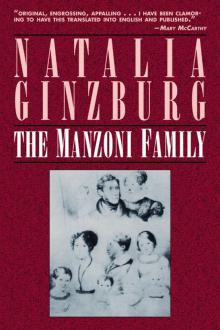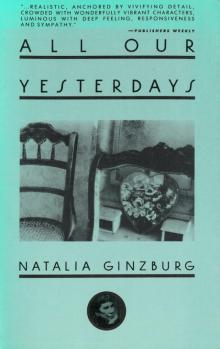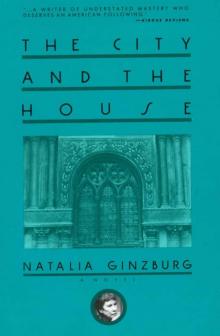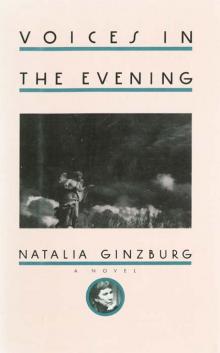- Home
- Natalia Ginzburg
The Manzoni Family Page 19
The Manzoni Family Read online
Page 19
When she was seventeen, Teresa met a friend of her brother Giuseppe, Count Stefano Decio Stampa, and at nineteen she married him. Stefano Decio had grown up in France, and had studied medicine at the Sorbonne. His mother, Julia, lived in Paris. The Stampas owned many houses in Milan, and many country estates. Teresa and her husband were living at Lesa in one of the Stampa villas, and had been married for only a few months, when Stefano Decio coughed blood. Neither he nor his wife chose to take it seriously. He treated himself with a diet and bleeding. Teresa was pregnant. In November 1819, in one of the Stampa houses in via Meravigli in Milan, she gave birth to a boy, who was called Giuseppe Stefano.
Stefano Decio was still unwell, but they decided to go to Paris to see his mother. In Paris, the painter Deveria did a pencil sketch of Teresa as a very beautiful young woman, with delicate features and cheeks, her large eyes lowered. Deveria also drew husband and wife together, sitting side by side, she in profile with her hands in her lap, he turning to look at her, with a sort of resignation in the set of his shoulders, his features and his smile.
They returned to Italy; he got worse. He went to Lesa with the baby for the fresh air. Teresa remained at Milan with a throat infection. She was always to be plagued with throat infections and inflammation. ‘I am better here than in Milan,’ her husband wrote to her, ‘I cough at night, but I cough it up easily, and then I still dream a lot, and always about food. I am sure I would be much better if I could ride. . . ’ But he was not even strong enough to walk. The letter is in French apart from a sentence in dialect; Teresa was also in the habit of writing partly in French, partly in Italian and partly in Milanese, a habit perhaps acquired from him, which she never lost. ‘If you could see the baby,’ he wrote, ‘he’s splendid, he tries to move everything he touches, however big. He is cutting his canines with no trouble at all’. People in Lesa made a row at night because it was the feast of San Martino; he felt like letting his pistol off at them. ‘A real cat orchestra at five in the morning, just when I am enjoying my best sleep.’ Marnati Mimi (Teresa’s mother, Marianna) had returned from the country estate at Torricella and was in the house the Borris owned at Borgo Gesù, but she was sleeping in a damp room, which was sure to bring on her rheumatism, and he was worried about it. He tackled his brother-in-law Giuseppe, ‘Pepino’, who was not bothered. Then he asked them to send ‘a half dozen birds’ because he liked making experiments on animals. The servant could get them from those bird-sellers on the steps of the Cathedral. He also wanted ‘a few yards of cheap muslin, the most ordinary sort, and some pieces of green gauze, as fine as possible, for my butterfly nets’.
Teresa joined him at Lesa when she was better. By now Stefano Decio was taking only rose-hip jam, a Genovese sweetmeat. He died in December.
He had made a will and divided his estate equally between his wife and son, assigning a pension to his mother, Julia. But the mother was not content with this allowance, and claimed a vast portion of his estate. She had made Stefano Decio sign a paper, when he was still under age, promising her an annuity. In the last days of his life, her son had written to her in Paris asking her to send back this document. Julia did not move from Paris and did not send it. When the will was read she began legal proceedings against Teresa and her grandson.
The law-suit lasted many years. Teresa had to cope with tiring journeys, discussions with magistrates, attorneys and lawyers, examine documents and make all the financial calculations; her brother Giuseppe helped her, but she wanted to investigate and supervise it all herself. The baby was delicate. Teresa was always worried about him. In the summer she would send him to Torricella to her parents, Marianna and Cesare; she did not go, either to keep an eye on her case, or to avoid putting her parents to too much expense. ‘Goodbye, my big little Stéphany, goodbye my angel, my life,’ she wrote to the little boy. ‘Goodbye, my Stéphany, most beloved of children.’ Stéphany was terribly capricious, and his grandmother complained to Teresa that she found him tiring. Teresa begged her to have patience ‘for the love of Stefanino, of me, and of all of us’. She had another throat inflammation which she treated with tamarind and with bleeding; then with emetic tartar, and with a vegetable juice that was like swallowing ‘squash made from mould’.
In 1822 part of the legacy became available to her. She sold the house in via Meravigli, and she and the little boy went to live in an apartment in the same street, with her mother and father, and Giacomo, the priest: Giuseppe had his own establishment. In the summer she and Stefano could go to the villa of Lesa, part of which, however, was still used by relatives of the Stampas, the Marchese Caccia-Piatti and family; they were noisy and disorderly and prevented her enjoying the garden. Stefanino wanted to spend the whole day by the lake throwing stones, he kept slipping out of the house and running down to the shore, and she was in a perpetual state of anxiety. She preferred to send him to grandmother Marianna at Torricella. At Torricella there was a boy called Cesarino whom Stefanino hated and used to kick. ‘Stefanino, my darling,’ wrote Teresa, ‘your dear Mama who misses you very much, asks you a great favour: don’t be nasty to Cesarino, who is so fond of you, although you don’t like him! Even if you don’t like Cesarino, remember God loves him, for He created him; my darling Stefanino, I think of you all night; you are always at the centre of my heart and mind; I’m sure you will listen to your Mama, because I know you love her so.’
In 1823, as soon as she had some money at her disposal, she ordered a ‘family portrait’ from the painter Francesco Hayez, paying for it in advance. It showed her mother, Giuseppe, herself and Stefanino. When she had the painting at home, she did not like it. She wrote about it to her mother. ‘I am not very pleased with Peppino’s portrait. I say nothing of my own; one is not allowed to judge one’s own portrait; everyone agrees it is perfectly painted. For myself I can only say he’s given me a most impressive double-chin, and I have a very slight one. But how fascinating and charming Stefanino’s portrait is, and how like him!’ She asked Hayez to make a few alterations. Hayez refused, and offered to give the money back and keep the painting. She did not want to. She sent it back for the alterations. Hayez made none. Years passed. She and Hayez exchanged furious letters. Finally Hayez kept the picture and gave her another one of a different subject. They resumed friendly relations.
In 1825 an uncle died, brother of grandmother Marianna, and the Borris inherited property, money and houses. They left via Meravigli and all went to the Bigli district.
Teresa was looking for a tutor for Stefanino. She found one Ghezzi who had been, she was told, tutor to the Manzoni boys for three years. She had heard of the Manzonis, but never seen them.
Stefanino had grown more robust in time, and was quite a pretty little boy. His mother thought he was extraordinarily intelligent. Grandmother Marianna felt some anxiety about him, he was so spoilt, and Teresa reassured her. ‘You are anxious about the little lad,’ she wrote to her at Torricella in summer 1827, ‘but I see him night and day and I’m not anxious at all; what a difference! Can two mothers who feel the same concern and the same love for such an enchanting little angel, find themselves at two extremes, one quite secure and the other fearful? This is impossible, so rest assured, like me. .
‘Her son slept beside her bed until he was a little boy, and until he was a young man in the same suite of rooms.
‘She played with him almost as if he were a little sister, without ever losing his respect. . . As tender as the most devoted mother, she became more severe and terrible than a father, if her son gave her cause. Although she took excessive care of his health, for fear he might become consumptive like his father (and as a result of his cossetting he developed habits of laziness which he never managed to shake off), yet she told the peasants with whom he played to hit him if he hit them; and she made him apologise to the servants if he offended them with some boyish insolence; and she asked him, with withering sarcasm, if he thought he was little Count Ciccin, described by Porta.’
This is how Stefano
Stampa remembered his mother, when he evoked his childhood many years later. He spoke of himself in the third person. His mother had been dead for some time. These memories were gathered into a volume which he published in 1885, and which bore only his initials, S. S.
In 1827 Teresa read I promessi sposi. She wrote about it to her mother. I’m reading Manzoni’s novel. Oh, Mama! how fine it is; he really is a man after my own heart. He depicts everything in such a natural way, and how beautiful and perfect that nature is! You will say that this implies that my nature too is beautiful and perfect; and why not? Was I not created by God and for God?’
She heard of Luigi Rossari, and wanted him to be Stefano’s tutor. Through Rossari she met Tommaso Grossi. She met Giovanni Torti and shortly after d’Azeglio. As Stefanino drew and painted, d’Azeglio let him come to his studio. Stefanino’s admiration for d’Azeglio was boundless.
When the law-suit was finally settled in court, Teresa was reconciled with her mother-in-law, Julia Stampa. They wrote to each other; the mother-in-law came to Milan to embrace Stefanino. The memory of their long legal quarrels was buried.
Teresa and Stefanino left her people and went to live in a house in the Monti district.
It was Grossi who spoke to Manzoni of Teresa. He described her as a cultured, intelligent, sensitive woman, devoted to her son and to her domestic responsibilities. He introduced her to him one evening at the theatre. Grossi knew Manzoni was tired of living alone, and that his mother wanted him to marry again. Stefano Stampa reports: ‘It seems that Manzoni sent or let Donna Giulia, his mother, go to call on her, and this lady was delighted, indeed quite enamoured with poor Teresa. She called on her again, and a few days later Manzoni came in person, and after a few more calls asked her to be his wife.’ The words ‘poor Teresa’ arise from the fact that later there were to be, between Giulia and Teresa, bitter disagreements, which caused pain to Teresa; but in any case, Teresa liked to have this adjective of commiseration added to her name.
Teresa hesitated about this proposal. Whether her hesitation was real or simulated is hard to say. The objections she put forward concerned her own poor health – she so often had bad throats, and other troubles – the thought of her own inadequacy for such an honour, and the fear that her son might not be happy. Perhaps the last was the only sincere objection.
Stefano was then seventeen. He said later that his mother came into his room one evening and said to him:
‘You know I have devoted my whole life to you. Everything I’ve done has been done with your good in mind. Now I have to tell you that Manzoni has asked me to be his wife. If I were to accept, it would be only in the hope that such a connection would be beneficial to you. But if you prefer us to live together on our own, apart from the world as we have done until now, tell me frankly and I shall reject this proposal.’
The son replied:
‘You are the best judge of what is good for me. Do what you think best for both of us.’
Then Teresa wrote to her own mother:
‘Don’t tell anyone except my brothers, promise faithfully not to tell anyone else that in one month I believe I shall be the wife of Alessandro Manzoni. I shall come to see you as soon as possible, I hope, but it may be as late as possible, as from one to four Manzoni is here, before one I am in bed, and after four it is too cold for me with my poor health, which has not been poor enough to put off Manzoni who wants me in all my physical and moral poverty. I need hardly tell you that, first of all, I wanted to know not only if this would hurt Stefano, but if he would like to have Manzoni for a father. It was Grossi who did everything for me. . . Alessandro will not pay calls; he never calls on anyone all year: not even his uncle Beccaria, although he spends weeks with him at Gessate. So when I come to see you, you will see in me both a daughter and a new son: Alessandro never goes out with a lady, but is always accompanied by his closest friends, though he never calls on them either.’ Then she wrote to a sister of her mother, Aunt Notburga, a nun: ‘My dear aunt, I have been considered capable of fulfilling new and sacred duties! Poor trampled wretch that I am, I have been sought out for the highest possible place! But pride will not find wings to reach me, and, though wife of Manzoni – of ALESSANDRO MANZONI – in my own eyes I shall still be poor Teresa.’ She also wrote to Giuseppe Bottelli, a priest at Arona, whom she had known well at Lesa; he replied: ‘I offer Your Ladyship my congratulations, although nothing can add to the summum bonum of soon being wife to Alessandro Manzoni. Placed on this most sublime height, the too-humble expression of a poor trampled wretch must be forgotten. . . Dearest Countess, take all diligent care of yourself that your health may become ever more precious.’ And Aunt Notburga to her sister Marianna: ‘My purpose in writing is to rejoice with you in Teresa’s marriage: Jacob’s prayers for her have been granted [Jacob, that is Giacomo, the priest]; in this marriage I see such a radiant sign of divine mercy towards your daughter, that I leave the talking to others, and thank God in the depths of my heart for His goodness. . .’ She enclosed Teresa’s letter: ‘She shows in it a great deal of respect for her husband, humility and piety; in short, she is already quite changed, and is preparing to undertake a happy career; I am very pleased, but let Jacob go on praying. . .’ The aunt’s letter breathes a sense of relief: Teresa must have caused the family considerable anxiety.
Tommaseo wrote to Cesare Cantú, who had written to him:
‘Thank you for the secret you confided in me, but don’t blame me if others are already talking about it. When I first heard it mentioned as an uncertain rumour, I feigned ignorance. When it was then presented as news, I could no longer pretend, especially as they now say it is a fait accompli, and as for the details, they know better than I do. All women’s gossip. As for me, I’m delighted; and his mother will no doubt be pleased; the family will gain fresh life, and his talent will be stirred. Here they say she’s an unbeliever, and galante, too. Do tell me the truth of the matter. . .’
We do not know what Cantú replied. We know only that, later in his memoirs, Stefano Stampa wote pages and pages on that ‘galante, too’. Cantú, in his Reminiscences, included Tommaseo’s letter without comment.
The wedding day was fixed for 2 January. Teresa ordered lots of clothes. She was a fragile, slender, graceful woman, small in stature, with thick, curly hair. She was then thirty-eight.
Manzoni’s sons and daughters came to meet her. She said she wanted to be a big sister to them.
The Provost of San Fedele, don Giulio Ratti, came to meet her. He probably spoke to her about the most suitable way of comporting herself in the household. She wrote to Manzoni: ‘I was in full agreement with everything he said. . . I am perfectly happy about it, and we parted in complete accord. Alessandro, will that Alessandro have a good night? There is one who would have stayed awake all night asking herself this question if she had not indulged in writing these few lines, in which is included the most tender embrace for a certain incomparable mother.’
The wedding took place on 2 January 1837. Teresa and Stefano moved into via del Morone. Disagreements with the ‘incomparable mother’ began at once.
Stefano Stampa, in his memoirs:
‘When she entered the house, donna Teresa left donna Giulia in complete charge. Needless to say, she did not interfere with the three sons, two of whom, as young men, were always out, and the last was at school; neither did she attempt to influence the girls: two of marriageable age, the third at school, and the fourth a little child, cared for in all material things by the French nanny, and educated, then later sent away to school, under the direction of her grandmother and her sisters. It did not cost donna Teresa to abdicate all influence in this way, as it was her own carefully considered choice, for she thought there was no need for anyone to interfere in the Manzoni family; and if there had been any need, any attempt to break old habits would only have led to disagreements.
‘Besides, her poor health would have been an insurmountable obstacle.’
Cantú:
‘When Enrichetta died, it was thought that Postquam primus amor deceptum morte fefellit [‘After my first love failed me, cheated by death. . .’, Aeneid IV, 17], in the autumn of life Alessandro must resign himself to a widower’s solitude, and be content to watch over Pietro’s family. But he felt the curse of solitude and the need of a companion. He chose Teresa, daughter of Cesare, one of the Borri counts (2nd January 1837), who had been wife to the nobleman Stefano Decio Stampa, and had a son in the prime of youth and hope. We wished him that repose which is often called happiness, and that he might find the domestic support customary in such marriages in the winter of life, where warmth is replaced by reciprocal help and common memories.
‘It is rare for a stepmother to bring comfort to children already adult. The newcomer, while feeling the great worth of possessing such a man, and without wishing as some claimed to wean him away from importunate friends and isolate him in order to absorb him, claimed more wifely authority than the meek Enrichetta had done. This was hurtful chiefly to donna Giulia, accustomed to being regarded as the mistress of the house. The change led to bitterness, which was bound to affect Alessandro.’
The 6th January, Costanza Arconati, from Bonn, to her sister Margherita (who had meanwhile married d’Azeglio’s friend, Collegno):
‘I haven’t heard a word about Manzoni’s marriage; it is no surprise because his mother’s letters indicated how keen she was on it. Yet this decision makes me sad. It takes away something of the aura of sublimity that surrounds him. When I consider all the particular circumstances, it seems an act of weakness. What does Fauriel say about it?’ And a few days later: ‘I was surprised to hear that a son of 17 was appended to Manzoni’s imprudent marriage. The girls have every right to grieve; and it’s natural that the public should judge Manzoni more severely than another. Tell me what Fauriel says. . . It’s a calumny to suggest Manzoni did not treat Enrichetta with every kindness. I am also convinced that he does not love the wife he has now as he loved Enrichetta, but he could not manage without a companion.’

 Happiness, as Such
Happiness, as Such The Dry Heart
The Dry Heart The Manzoni Family
The Manzoni Family A Place to Live
A Place to Live All Our Yesterdays
All Our Yesterdays The Little Virtues
The Little Virtues The City and the House
The City and the House The Road To The City
The Road To The City Voices In The Evening
Voices In The Evening